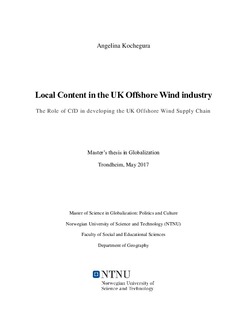| dc.description.abstract | The United Kingdom is the world leader in Offshore Wind (OW) with total installed capacity over 5GW which is expected to reach 15GW by 2025 (Scottish Enterprise, 2016). Moreover, the UK is widely recognized for its stable policy regime and the level of regulatory and price support in the OW sector that have attracted foreign OW project developers from across the world.
The cost reduction is important for the UK OW industry in order for the electricity generated form the OW power to be competitive with the other RE sources as well as the traditional energy sources like oil and gas, and thus be affordable for the end consumer. The UK Government is committed to enable further cost reduction in the industry, thus improving cost competitiveness of the electricity generated from OW in order to fully realize its OW potential to be able to meet the RE and climate change targets.
This paper analyzes the extent of the UK content in the major segment of the UK OW supply chain, the Balance of plant. Balance of Plant is one of five major OW supply chain segments involved in the development of an offshore wind farm project. The other segments are Development and Consent, Wind Turbine, Installation & Commissioning and Operations & Maintenance. Balance of Plant is involved in the manufacturing and supply of all the OW farm components besides Turbines and represents one of the largest procurement choices in OW projects, after Turbines, which significantly affects the level of local content (LC) in the UK OW industry. Balance of Plant has the smallest share of the UK content compared to other OW segments. However, it is estimated to have the most potential for cost reduction in the UK OW sector given that the UK manufacturing capacity within this segment will increase, which will allow eventually obtain economies of scale that will contribute to cost reduction.
The paper present the analysis of the UK content in the UK OW projects. Both OW projects, that have to comply with local content requirements (LCRs) meaning that they have to award a proportion of the main contracts to UK based companies, and those OW projects that do not have LC obligations, have been analyzed to determine whether the UK Government policy claims on LCRs in the OW industry succeed in enhancing LC in the UK OW industry. Given that the UK Government is likely to increase its UK content expectations (BVG Associates, 2017), the practical limits of the UK content within Balance of Plant have been considered. The conclusion has been drawn on whether it is realistic to grow the UK content in this segment thus contributing to cost reduction and development of the UK OW industry. Furthermore, the reasons for the small share of LC in the Balance of Plant segment of the OW projects with LC obligations are highlighted in this report. | nb_NO |
